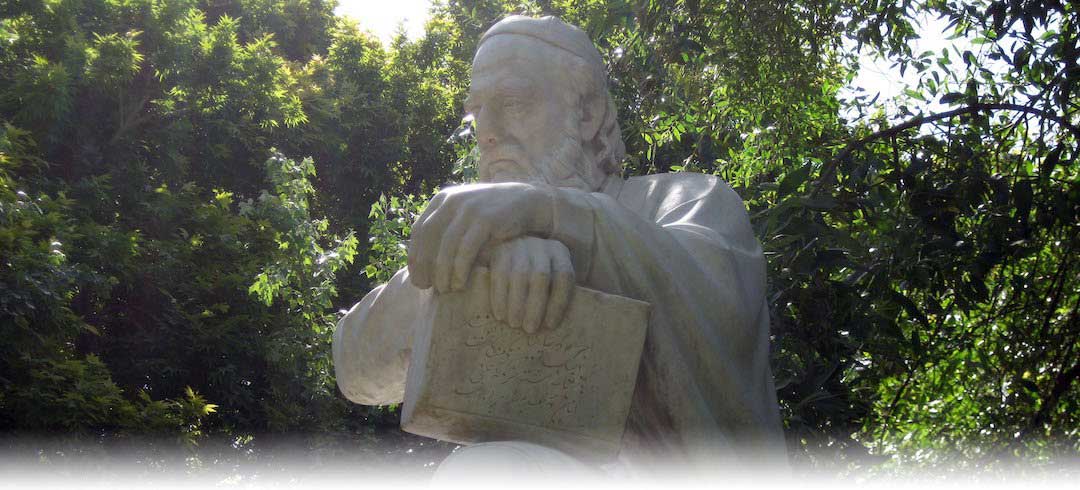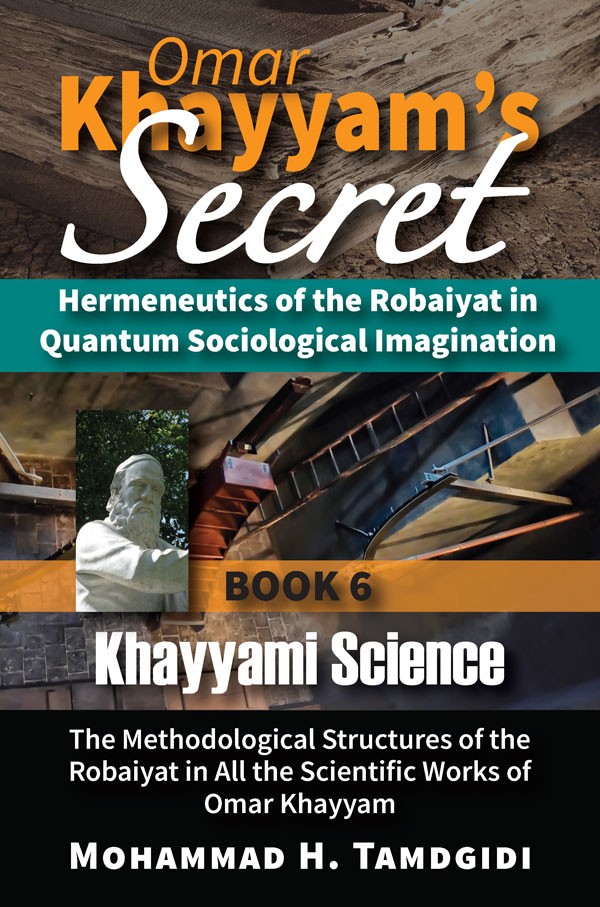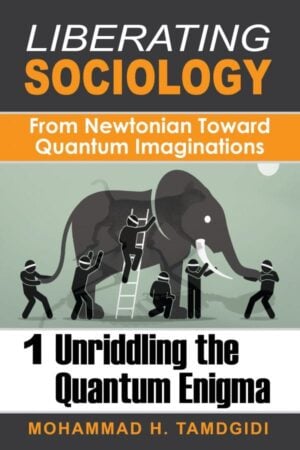Book Section: CHAPTER III—Omar Khayyam’s Treatise on Dividing A Circle Quadrant: The Arabic Text, the Persian Translation by Gholamhossein Mosaheb, and Its New English Translation, Followed by Textual Analysis — by Mohammad H. Tamdgidi
$20.00
This essay titled “Omar Khayyam’s Treatise on Dividing A Circle Quadrant: The Arabic Text, the Persian Translation by Gholamhossein Mosaheb, and Its New English Translation, Followed by Textual Analysis” is the third chapter of the book Khayyami Science: The Methodological Structures of the Robaiyat in All the Scientific Works of Omar Khayyam, which is the sixth volume of the twelve-book series Omar Khayyam’s Secret: Hermeneutics of the Robaiyat in Quantum Sociological Imagination, authored by Mohammad H. Tamdgidi.
Description
Abstract
This essay titled “Omar Khayyam’s Treatise on Dividing A Circle Quadrant: The Arabic Text, the Persian Translation by Gholamhossein Mosaheb, and Its New English Translation, Followed by Textual Analysis” is the third chapter of the book Khayyami Science: The Methodological Structures of the Robaiyat in All the Scientific Works of Omar Khayyam, which is the sixth volume of the twelve-book series Omar Khayyam’s Secret: Hermeneutics of the Robaiyat in Quantum Sociological Imagination, authored by Mohammad H. Tamdgidi.
In this chapter, the Arabic manuscript, a Persian translation by the late Gholamhossein Mosaheb (1960), and Tamdgidi’s new English translation based on the latter, of a treatise by Khayyam known as, “Treatise on Dividing A Circle Quadrant” are shared and analyzed. Tamdgidi’s purpose is to understand how the treatise illuminates the structures of Khayyam’s thinking when solving a specific scientific problem, and whether such an understanding can shed light on how he may have gone about composing poetry.
Khayyam’s treatise is concerned with the problem of finding a certain point on a circle quadrant such that if a perpendicular line is drawn from it to a radius, the ratio of the larger to the smaller segments created on that radius by the perpendicular equals the ratio of the length of the radius to the length of that perpendicular. It is not known when Khayyam wrote the treatise, as no date is given at the end of the treatise itself. However, in the treatise, Khayyam expresses his wish that at a later date when time allows he planned to write a more comprehensive treatise in algebra, expanding on the brief classification and explanations of equations he introduces in this treatise. We know that Khayyam fulfilled that wish. However, since we do not know when exactly Khayyam wrote his major treatise in algebra, the exact dates of writing of neither of the two treatises are known. It is reasonable to assume, however, that all of Khayyam’s scientific treatises were completed by 470 LH (AD 1077), when he completed his major treatise on Euclid’s postulates, from then on focusing on his theological and philosophical writings.
Tamdgidi’s purpose in the study of Khayyam’s treatise is not evaluative but hermeneutic. For the purpose for which he studies Khayyam’s scientific texts in this book, a specialty is not required beyond a basic understanding of what Khayyam sets out to do in each treatise. Khayyam’s scientific treatises offer much more than technical details, and one can learn much about how he solves scientific problems. Reading the various scientific treatises of Khayyam relationally is also another insight one can gain since reading a treatise alone and in isolation from others may not give us an adequate sense of each treatise and why Khayyam wrote it. Tamdgidi shows that indeed Khayyam’s treatises reveal much also about Khayyam’s pedagogical style, the underlying theological worldview motivating his scientific work, and in particular the poetic nature of his geometric method of solving algebraic equations.
Tamdgidi’s analysis of Khayyam’s treatise on dividing a circle quadrant is conducted by way of addressing three questions Khayyam himself suggested in his philosophical writings as a procedural method: “whether it exists” “what exists” and “why it exists.” In other words, we wish to first ascertain whether the existing treatise or parts thereof were written by Khayyam, then explore what the treatise is about, and then finally ask why it was written. Regarding the first question, Tamdgidi argues that there is no reason to doubt that the brief addendum at the end of Khayyam’s treatise is by anyone other than Khayyam; the burden of proof is on those who cast such a doubt. He also reports that aside from the full-text manuscript of the treatise reproduced in Mosaheb, a partial copy that appears to be from another manuscript source also exists, reference for which is provided in this chapter.
In the treatise, Khayyam poses a geometric problem to solve and he solves it by way of what he calls an analysis-synthesis method. First, he assumes the problem as having been solved, examining its notable and interesting properties. Then, he splits it analytically into the components of its required solution, and having found the method of solving it, he reintegrates and synthesizes his effort at the end. In an addendum, he also offers a shorter solution related to the first analysis he offered in the treatise but intentionally left incomplete. The addendum solution is short because it assumes the details that he had already introduced.
The treatise offers us a good illustration of Khayyam not just being an abstract and pure mathematician or algebraist/geometrist per se, but also an applied scientist as well. As we found him (in previous chapters of this volume) interested in music theory and tetrachords, playing some music himself to identify the better sounding types from others, or designing/inventing a new balance or offering algebraic and geometric solutions in determining the weights of gold and silver in a body composed of them, here also Khayyam is trying, in respect for those inquiring from him, to offer both theoretical and a variety of practical solutions to a specific problem. Even though, as he states, the detailed problem may not have been on his own agenda to take up, however, he uses the opportunity to dwell on strategic matters for algebra and geometry, recognizing that dealing with details also offers an opportunity to raise and solve more strategic scientific problems.
Tamdgidi shows in his analysis of the treatise that the goal Khayyam set out to achieve is similar, though not entirely, to finding the traditional golden ratio that results in repetitive geometric patterns. This becomes apparent when we consider the properties Khayyam identifies in a triangle created as a result of his solving the problem as posed in the treatise. Tamdgidi shows that in Khayyam’s formulation, the ratio he finds can be calculated by solving the cubic equation 2K3 = 2K + 1.
An interesting aspect of how Khayyam goes about offering his classification of various algebraic equations is that of the meanings he attributes to the cube, the square, the thing (or root), and the number in terms of what they represent in algebraic equations. For Khayyam, number has no basis in reality as such, being a mental construct, a universal that acquires reality only when expressing material objects. And the material objects representing continuous magnitudes are in his view basically comprised of three dimensions, the line being one-dimensional, the surface being two-dimensional, and the volume or solid being three-dimensional. In Khayyam’s view, algebraic objects of fourth degrees or higher are abstract constructs that have no basis in external reality and therefore are not, in his view, worthy of inclusion in his classification scheme in need of solutions.
Of course, we know that today, especially in the age of quantum science, holding such a view is deemed outdated, when even what was considered to be an imaginary number such as the root of minus one (that is, i) plays an important part in understanding especially subatomic (and by implication all) reality. At the time Khayyam wrote his treatise, even negative numbers were not regarded as solutions. It is for this reason that some of the solutions Khayyam himself finds when solving some algebraic equations (as we shall see in the next chapter) are dismissed by him as indicating an equation or case having no solution. From a hermeneutic point of view, however, understanding Khayyam in terms of how he himself, at that time, viewed algebraic terms and mathematical objects is very important. This is because, from his point of view, science dealt with understanding reality as is, and therefore for him there had to be a representational correspondence between the abstract concepts of mathematics and algebra on one hand, and real objects, on the other, for solving problems to have scientific value and purpose.
It is for this reason that we find in Khayyam’s study of ratio and proportionality also a continuing and persistent emphasis on understanding them as real objects. For him, it is important to hear, to weigh, to see, to experience, ratios and proportionality, in external reality, as embedded in real objects, rather than treated as merely abstract and imaginary objects. So, the same way he finds more value in studying numbers in association with objects in external reality—as evident in how he defines the line, the surface, and the volume/solid as representing things, squares, and cubes—he wishes to educate his readers to regard ratios and proportionality also in terms of how they can be heard (as in musical tetrachords), weighed (in working with scales and balances), visualized, and experienced.
In Tamdgidi’s view, the late Turkish architectural historian Alpay Özdural (d. 2003) in his 1995 article, “Omar Khayyam, Mathematics, and Conversazioni with Artisans,” (Journal of the Society of Art Historians, 1995:54-71) made a significant contribution to Khayyami studies and especially to a contextual understanding of Omar Khayyam’s treatise on dividing a circle quadrant. Özdural showed that the problem Khayyam posed and offered various solutions for in his treatise on dividing a circle quadrant was contextually rooted in the architectural problem of designing geometric ornamental patterns in buildings. For the purpose Khayyam invented, similar to but differently from the traditional golden ratio and associated triangle, a new “Khayyami Ratio” and associated “Khayyami Triangle” using which repetitive patterns could be created in practical ways by artisans for architectural purposes.
What the study of Khayyam’s treatise reveals was that he was exposed to the idea of how a wider intricate ornamental pattern can be created by means of a triangular building block having special properties. He basically had to imagine how from a basic triangular building block a collection of intricate patterns can be constructed, and to find a way, he actually developed a simultaneously geometric and algebraic solution, his own “formula,” so to speak, for the problem. So, when we read in attributed quatrains the notion of a Khayyam sewing tents of wisdom, we can find parallels for such an idea of constructing a triangular tent that is sewn out of a series of smaller triangular tents, as if sewing a quilt for such a tent of wisdom.
We have already seen how Khayyam’s interests in ratios and proportionality are often expressed in terms of concrete scientific questions and problems. In the study of musical tetrachords, he was interested in understanding how they sound to the ear, and to do so he tends to offer a classification of tetrachord types. In terms of solving the concrete problem of finding the weights of gold and silver in a body composed of them, he offers both geometric and algebraic methods, both framed around understanding problems of ratios and proportionality. Now, in the treatise on dividing the circle quadrant, we also find, thanks to the late Alpay Özdural’s important work, that he was trying to offer practical solutions about a problem having to do with designing geometric ornamental patterns in architectural contexts.
Even though Khayyam himself says that he would not have stumbled upon such a matter of detail on his own, he nevertheless does his best to offer various practical ways of solving the specific problem posed in the treatise, and uses the opportunity to launch his new project of systematically classifying and solving all types of algebraic equations involving numbers, roots, squares, and cubes by way of a geometric method of conic sections (where needed)—one that in essence involved approaching the problem in a way that regards the algebraic terms as representing the geometric objects lines, surfaces, and volumes. Tamdgidi argues that such a method inherently evokes a poetic imagination for solving algebraic equations in a geometric way. It appears that not only was Khayyam a scientist who wrote poetry, but also his scientific method itself was poetic.
Recommended Citation
Tamdgidi, Mohammad H. 2023. “CHAPTER III—Omar Khayyam’s Treatise on Dividing A Circle Quadrant: The Arabic Text, the Persian Translation by Gholamhossein Mosaheb, and Its New English Translation, Followed by Textual Analysis .” Pp. 119-202 in Omar Khayyam’s Secret: Hermeneutics of the Robaiyat in Quantum Sociological Imagination: Book 6: Khayyami Science: The Methodological Structures of the Robaiyat in All the Scientific Works of Omar Khayyam. (Human Architecture: Journal of the Sociology of Self-Knowledge: Vol. XIX, 2023. Tayyebeh Series in East-West Research and Translation.) Belmont, MA: Okcir Press.
Where to Purchase Complete Book: The various editions of the volume of which this Book Section is a part can be ordered from the Okcir Store and all major online bookstores worldwide (such as Amazon, Barnes&Noble, Google Play, and others).
Read the Above Publication Online
To read the above publication online, you need to be logged in as an OKCIR Library member with a valid access. In that case just click on the large PDF icon below to access the publication. Make sure you refresh your browser page after logging in.





